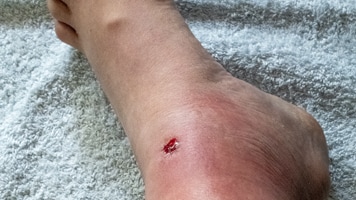Key points
- Multiple bacteria can cause cellulitis.
- Cellulitis typically involves erythema, pain, and warmth locally and can include systemic symptoms.
- Diagnosed by physical examination, cellulitis is treated with antibiotics.
- Prevention focuses on good wound care.
- Follow recommended guidelines when caring for patients with cellulitis.

Causes
Multiple bacteria can cause cellulitis, an infection in the subcutaneous tissues.
This page focuses on one of the most common causes of cellulitis: Streptococcus pyogenes. S. pyogenes are also called group A Streptococcus (group A strep bacteria).
Risk factors
Anyone can get cellulitis, but some factors increase a person's risk.
Breaks in the skin
Disruption of the cutaneous barrier is a risk factor for developing cellulitis:
- Chickenpox and shingles
- Chronic skin conditions (e.g., eczema)
- Fungal skin infections (e.g., athlete's foot)
- Injection drug use
- Injuries and wounds (e.g., ulcers)
Medical conditions
- Chronic edema
- Impaired lymphatic drainage of the limbs
- Obesity
- Venous insufficiency
Increased risk for repeat infections
The following conditions increase a person's risk of recurrent cellulitis infections:
- Impaired lymphatic drainage of the limbs
- Venous insufficiency
- Due to saphenous vein removal for coronary artery bypass grafting
Clinical features
Local signs
Local signs of inflammation are present in most cellulitis cases:
- Erythema
- Pain
- Warmth
Systemic symptoms
Systematic symptoms may be present:
- Chills
- Fever
- Malaise
These symptoms can be accompanied by lymphangitis and, less frequently, bacteremia. An elevated white blood cell count may also be present.
Differentiating other skin infections
Cellulitis affects structures that are deeper than areas affected by impetigo or erysipelas.
Diagnosis and testing
Diagnosis of cellulitis is usually made clinically.
Routine culture not recommended
For cellulitis, the Infectious Diseases Society of America (IDSA) doesn't recommend routine collection of cultures, including
- Biopsies
- Blood
- Cutaneous aspirates
- Swabs
When culture is recommended
However, they may be useful when severe systematic features (such as hypotension) are present or atypical pathogens are suspected. For this reason, these procedures are recommended by IDSA for
- Animal bites
- Immersion injuries
- People with immunocompromised status
Treatment
Never delay the initiation of treatment while waiting for culture results.
Use culture results, when available, to tailor antibiotic therapy.
Antibiotic therapy for non-purulent cellulitis
IDSA recommends treatment with an antibiotic that is active against streptococci. Healthcare providers may select antibiotics that cover both Staphylococcus aureus and group A strep.
Treatment options
Treat mild cellulitis with oral antibiotics and consider intravenous antibiotics for systematic infections. Group A strep remains susceptible to beta-lactam antibiotics.
Oral antibiotics
Treatment duration
The recommended treatment duration is 5 days for most cellulitis cases. Cases in which there hasn't been improvement during this time period may require longer durations of treatment.
Other treatment
In addition, the following actions are recommended to reduce the risk of recurrent infection:
- Elevate the affected area
- Treat predisposing factors (e.g., edema, underlying skin disorders)
Complications
Complications from cellulitis are uncommon but can include serious infections.
Occasionally: Cellulitis can result in bacteremia.
Rarely: Cellulitis can result in deep tissue infections, such as
- Infective endocarditis
- Necrotizing soft tissue infections
- Osteomyelitis
- Septic thrombophlebitis
- Suppurative arthritis
Prevention
Reduce the spread of group A strep bacteria with standard infection control practices, including good hand hygiene and respiratory etiquette.
Wound care
Early identification and management of superficial skin lesions is also key to cellulitis prevention. Patients with recurrent lower-extremity cellulitis should be inspected for tinea pedis (athlete's foot) and treated if present. Traumatic or bite wounds should be cleaned and managed appropriately (e.g., antibiotic prophylaxis, surgical debridement if indicated) to prevent secondary infections.
Resources
Treatment guidelines
Practice guidelines for the diagnosis and management of skin and soft tissue infections
Infectious Diseases Society of America
